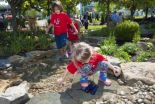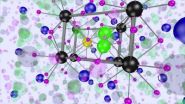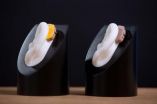(Press-News.org) RIVERSIDE, Calif. — Recent studies have shown that the Earth's tropical belt — demarcated, roughly, by the Tropics of Cancer and Capricorn — has progressively expanded since at least the late 1970s. Several explanations for this widening have been proposed, such as radiative forcing due to greenhouse gas increase and stratospheric ozone depletion.
Now, a team of climatologists, led by researchers at the University of California, Riverside, posits that the recent widening of the tropical belt is primarily caused by multi-decadal sea surface temperature variability in the Pacific Ocean. This variability includes the Pacific Decadal Oscillation (PDO), a long-lived El Niño-like pattern of Pacific climate variability that works like a switch every 30 years or so between two different circulation patterns in the North Pacific Ocean. It also includes, the researchers say, anthropogenic pollutants, which act to modify the PDO.
Study results appear March 16 in Nature Geoscience.
"Prior analyses have found that climate models underestimate the observed rate of tropical widening, leading to questions on possible model deficiencies, possible errors in the observations, and lack of confidence in future projections," said Robert J. Allen, an assistant professor of climatology in UC Riverside's Department of Earth Sciences, who led the study. "Furthermore, there has been no clear explanation for what is driving the widening."
Now Allen's team has found that the recent tropical widening is largely driven by the PDO.
"Although this widening is considered a 'natural' mode of climate variability, implying tropical widening is primarily driven by internal dynamics of the climate system, we also show that anthropogenic pollutants have driven trends in the PDO," Allen said. "Thus, tropical widening is related to both the PDO and anthropogenic pollutants."
Widening concerns
Tropical widening is associated with several significant changes in our climate, including shifts in large-scale atmospheric circulation, like storm tracks, and major climate zones. For example, in Southern California, tropical widening may be associated with less precipitation.
Of particular concern are the semi-arid regions poleward of the subtropical dry belts, including the Mediterranean, the southwestern United States and northern Mexico, southern Australia, southern Africa, and parts of South America. A poleward expansion of the tropics is likely to bring even drier conditions to these heavily populated regions, but may bring increased moisture to other areas.
Widening of the tropics would also probably be associated with poleward movement of major extratropical climate zones due to changes in the position of jet streams, storm tracks, mean position of high and low pressure systems, and associated precipitation regimes. An increase in the width of the tropics could increase the area affected by tropical storms (hurricanes), or could change climatological tropical cyclone development regions and tracks.
Belt contraction
Allen's research team also showed that prior to the recent (since ~1980 onwards) tropical widening, the tropical belt actually contracted for several decades, consistent with the reversal of the PDO during this earlier time period.
"The reversal of the PDO, in turn, may be related to the global increase in anthropogenic pollutant emissions prior to the ~ early 1980s," Allen said.
Analysis
Allen's team analyzed IPCC AR5 (5th Assessment Report) climate models, several observational and reanalysis data sets, and conducted their own climate model experiments to quantify tropical widening, and to isolate the main cause.
"When we analyzed IPCC climate model experiments driven with the time-evolution of observed sea surface temperatures, we found much larger rates of tropical widening, in better agreement to the observed rate--particularly in the Northern Hemisphere," Allen said. "This immediately pointed to the importance of sea surface temperatures, and also suggested that models are capable of reproducing the observed rate of tropical widening, that is, they were not 'deficient' in some way."
Encouraged by their findings, the researchers then asked the question, "What aspect of the SSTs is driving the expansion?" They found the answer in the leading pattern of sea surface temperature variability in the North Pacific: the PDO.
They supported their argument by re-analyzing the models with PDO-variability statistically removed.
"In this case, we found tropical widening — particularly in the Northern Hemisphere — is completely eliminated," Allen said. "This is true for both types of models--those driven with observed sea surface temperatures, and the coupled climate models that simulate evolution of both the atmosphere and ocean and are thus not expected to yield the real-world evolution of the PDO.
"If we stratify the rate of tropical widening in the coupled models by their respective PDO evolution," Allen added, "we find a statistically significant relationship: coupled models that simulate a larger PDO trend have larger tropical widening, and vice versa. Thus, even coupled models can simulate the observed rate of tropical widening, but only if they simulate the real-world evolution of the PDO."
Future work
Next, the researchers will be looking at how anthropogenic pollutants, by modifying the PDO and large scale weather systems, have affected precipitation in the Southwest United States, including Southern California.
"Future emissions pathways show decreased pollutant emissions through the 21st century, implying pollutants may continue to drive a positive PDO and tropical widening," Allen said.
INFORMATION:
Allen was joined in the study by Mahesh Kovilakam, a postdoctoral researcher working in his lab; and Joel R. Norris at the Scripps Institution of Oceanography, UC San Diego.
A grant to Allen from the NASA Energy and Water Cycle Study funded the study.
The University of California, Riverside is a doctoral research university, a living laboratory for groundbreaking exploration of issues critical to Inland Southern California, the state and communities around the world. Reflecting California's diverse culture, UCR's enrollment has exceeded 21,000 students. The campus opened a medical school in 2013 and has reached the heart of the Coachella Valley by way of the UCR Palm Desert Center. The campus has an annual statewide economic impact of more than $1 billion. A broadcast studio with fiber cable to the AT&T Hollywood hub is available for live or taped interviews. UCR also has ISDN for radio interviews. To learn more, call (951) UCR-NEWS.
Climatologists offer explanation for widening of Earth's tropical belt
UC Riverside-led research points to the Pacific Decadal Oscillation and anthropogenic pollutants
2014-03-18
ELSE PRESS RELEASES FROM THIS DATE:
Strengthening learning in children: Get outside and play
2014-03-18
University of Cincinnati researchers are reporting on the educational and health benefits of specially created outdoor play environments for children. Victoria Carr, a UC associate professor of education and director of the UC Arlitt Child and Family Research and Education Center, and Eleanor Luken, a former UC research associate for the Arlitt Center and current doctoral student at City University of New York, take a look at this growing trend around the world in an article published this month in the International Journal of Play.
Typically called playscapes, these ...
Bright future for protein nanoprobes
2014-03-18
The term a "brighter future" might be a cliché, but in the case of ultra-small probes for lighting up individual proteins, it is now most appropriate. Researchers at the U.S. Department of Energy (DOE)'s Lawrence Berkeley National Laboratory (Berkeley Lab) have discovered surprising new rules for creating ultra-bright light-emitting crystals that are less than 10 nanometers in diameter. These ultra-tiny but ultra-bright nanoprobes should be a big asset for biological imaging, especially deep-tissue optical imaging of neurons in the brain.
Working at the Molecular Foundry, ...
First guidelines for patients with pulmonary hypertension in sickle cell disease
2014-03-18
(Boston) –Boston Medical Center (BMC) and Boston University School of Medicine (BUSM) physicians have helped create the first set of clinical guidelines for treating patients with pulmonary hypertension in sickle cell disease. Elizabeth Klings, MD, director of the pulmonary hypertension inpatient and education program at BMC and associate professor of medicine at BUSM, spearheaded the development of these guidelines, which are published in the American Journal of Respiratory and Critical Care Medicine.
Several studies conducted in the past decade have demonstrated that ...
Moffitt researchers discover new mechanism allowing tumor cells to escape immune surve
2014-03-18
The immune system plays a pivotal role in targeting cancer cells for destruction. However, tumor cells are smart and have developed ways to avoid immune detection. A collaborative team of researchers at Moffitt Cancer Center recently discovered a novel mechanism that lung cancer cells use to block detection by a type of immune cell called a natural killer cell (NK cell).
NK cells find and destroy virally infected cells and also play an important role in detecting and killing tumor cells. However, tumors produce high amounts of a protein called Transforming Growth ...
Reducing anxiety with a smartphone app
2014-03-18
Playing a science-based mobile gaming app for 25 minutes can reduce anxiety in stressed individuals, according to research published in Clinical Psychological Science, a journal of the Association for Psychological Science.
The study suggests that "gamifying" a scientifically-supported intervention could offer measurable mental health and behavioral benefits for people with relatively high levels of anxiety.
"Millions of people suffering from psychological distress fail to seek or receive mental health services. A key factor here is that many evidence-based treatments ...
Only 1 fifth of people with hearing problems wear a hearing aid
2014-03-18
Just a fifth of people with hearing problems wear a hearing aid, a study by The University of Manchester has found.
The study, published in the journal Ear and Hearing, looked at the habits of 160,000 people in the UK aged 40 to 69 years. It found 10.7 per cent of adults had significant hearing problems when listening to speech in the presence of background noise - but only 2.1 per cent used a hearing aid.
One in 10 middle aged adults had substantial hearing problems and were more likely to be from a working class or ethnic minority background.
Dr Piers Dawes, from ...
Scent of the familiar: You may linger like perfume in your dog's brain
2014-03-18
An area of the canine brain associated with reward responds more strongly to the scents of familiar humans than it does to the scents of other humans, or even to those of familiar dogs.
The journal Behavioural Processes published the results of the first brain-imaging study of dogs responding to biological odors. The research was led by Gregory Berns, director of the Center for Neuropolicy at Emory University.
"It's one thing when you come home and your dog sees you and jumps on you and licks you and knows that good things are about to happen," Berns says. "In our experiment, ...
Analysis of 50 years of hit songs yields tips for advertisers
2014-03-18
Researchers from North Carolina State University have analyzed 50 years' worth of hit songs to identify key themes that marketing professionals can use to craft advertisements that will resonate with audiences.
"People are exposed to a barrage of advertisements and they often respond by tuning out those advertisements. We wanted to see what we could learn from hit songs to help advertisers break through all that clutter," says Dr. David Henard, a professor of marketing at NC State and lead author of a paper describing the research. "We also wanted to see if there were ...
Rats' brains may 'remember' odor experienced while under general anesthesia
2014-03-18
Rats' brains may remember odors they were exposed to while deeply anesthetized, suggests research in rats published in the April issue of Anesthesiology.
Previous research has led to the belief that sensory information is received by the brain under general anesthesia but not perceived by it. These new findings suggest the brain not only receives sensory information, but also registers the information at the cellular level while anesthetized without behavioral reporting of the same information after recovering from anesthesia.
In the study, rats were exposed to a ...
NSF-funded researchers say Antarctic telescope may have provided the first direct evidence of cosmic
2014-03-18
Researchers with the National Science Foundation-funded BICEP2 Collaboration today announced that their telescope in Antarctica has allowed them to collect what they believe is the first direct evidence for cosmic inflation.
Inflation is the cataclysmic event in which, in a fleeting fraction of a second following the Big Bang, the infant universe expanded exponentially, stretching far beyond the view of the best telescopes.
Modern astronomy is built around the theory that almost 14 billion years ago, the universe burst into existence in an extraordinary event that ...
LAST 30 PRESS RELEASES:
Tracing the quick synthesis of an industrially important catalyst
New software sheds light on cancer’s hidden genetic networks
UT Health San Antonio awarded $3 million in CPRIT grants to bolster cancer research and prevention efforts in South Texas
Third symposium spotlights global challenge of new contaminants in China’s fight against pollution
From straw to soil harmony: International team reveals how biochar supercharges carbon-smart farming
Myeloma: How AI is redrawing the map of cancer care
Manhattan E. Charurat, Ph.D., MHS invested as the Homer and Martha Gudelsky Distinguished Professor in Medicine at the University of Maryland School of Medicine
Insilico Medicine’s Pharma.AI Q4 Winter Launch Recap: Revolutionizing drug discovery with cutting-edge AI innovations, accelerating the path to pharmaceutical superintelligence
Nanoplastics have diet-dependent impacts on digestive system health
Brain neuron death occurs throughout life and increases with age, a natural human protein drug may halt neuron death in Alzheimer’s disease
SPIE and CLP announce the recipients of the 2025 Advanced Photonics Young Innovator Award
Lessons from the Caldor Fire’s Christmas Valley ‘Miracle’
Ant societies rose by trading individual protection for collective power
Research reveals how ancient viral DNA shapes early embryonic development
A molecular gatekeeper that controls protein synthesis
New ‘cloaking device’ concept to shield sensitive tech from magnetic fields
Researchers show impact of mountain building and climate change on alpine biodiversity
Study models the transition from Neanderthals to modern humans in Europe
University of Phoenix College of Doctoral Studies releases white paper on AI-driven skilling to reduce burnout and restore worker autonomy
AIs fail at the game of visual “telephone”
The levers for a sustainable food system
Potential changes in US homelessness by ending federal support for housing first programs
Vulnerability of large language models to prompt injection when providing medical advice
Researchers develop new system for high-energy-density, long-life, multi-electron transfer bromine-based flow batteries
Ending federal support for housing first programs could increase U.S. homelessness by 5% in one year, new JAMA study finds
New research uncovers molecular ‘safety switch’ shielding cancers from immune attack
Bacteria resisting viral infection can still sink carbon to ocean floor
Younger biological age may increase depression risk in older women during COVID-19
Bharat Innovates 2026 National Basecamp Showcases India’s Most Promising Deep-Tech Ventures
Here’s what determines whether your income level rises or falls
[Press-News.org] Climatologists offer explanation for widening of Earth's tropical beltUC Riverside-led research points to the Pacific Decadal Oscillation and anthropogenic pollutants





